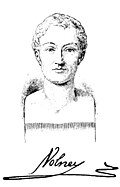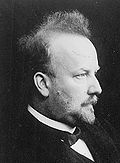Christ myth theory
The Christ myth theory (also called the Jesus myth theory) is the theory that Jesus of Nazareth, the God of Christianity and of the Bible's Gospels, is merely a myth. The Christ myth theory is a fringe theory, supported by few historians, mostly atheists.[1][2][web 1][q 1] It deviates from the main historical view, which is that a historical Jesus who was crucified in the 1st-century Roman province of Judea.[3][4] There are different meaning used for the word myth.[5][6][7][8] Because of this, there are many different views about how Jesus could be a myth.
Christ Myth Theory Media
A third-century fragment of Paul's letter to the Romans
French historian Constantin-François Volney, one of the earliest myth theorists
German Professor David Strauss
German Professor Arthur Drews
American New Testament scholar Robert M. Price
British academic John M. Allegro
Canadian author Tom Harpur
Notes
- ↑ Ehrman, Bart (26 June 2015). "Kickstarting a Debate". The Bart Ehrman Blog. Retrieved 15 September 2017.
- ↑ Gullotta (2017): "[Per Jesus mythicism] Given the fringe status of these theories, the vast majority have remained unnoticed and unaddressed within scholarly circles."
References
- ↑ Van Voorst
- ↑ Burridge
- ↑ Ehrman
- ↑ Stanton
- ↑ Remsburg, John (1909) The Christ Archived 2008-08-27 at the Wayback Machine
- ↑ see J. W. Rogerson "Slippery words: Myth" in Dundes, 1984 Sacred narrative, readings in the theory of myth pg 62-71,
- ↑ Marshall, Ian Howard. I Believe in the Historical Jesus. Regent College Publishing, 2004, p. 27-29.
- ↑ See Price's four definitions in the Jesus: Fact or Fiction? debate between Dr. Robert Price and Rev. John Rankin







